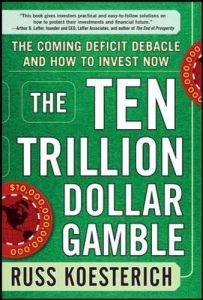Join getAbstract to access the summary!

Join getAbstract to access the summary!
Russ Koesterich
The Ten Trillion Dollar Gamble
The Coming Deficit Debacle and How to Invest Now
McGraw-Hill, 2011
What's inside?
This book can help you make money and add to your peace of mind in challenging economic times.
Recommendation
A timely book on personal finance with actionable advice is rare, but investment expert Russ Koesterich delivers specific guidance for investors. He jumps into the current debate on the US budget deficit and suggests ways to prepare your portfolio for an uncertain, “deficit-driven” future. Koesterich details which strategies, asset classes and instruments offer potential safe harbors and good returns amid the grim reality of structural deficit economics. getAbstract finds his discussion of the deficit informative and useful, though at times repetitive, and recommends his book to those who are weighing their options for wise actions in financially challenging times.
Summary
About the Author
Russ Koesterich is chief investment strategist for iShares and global head of investment strategy for BlackRock Scientific Active Equities.
















Comment on this summary